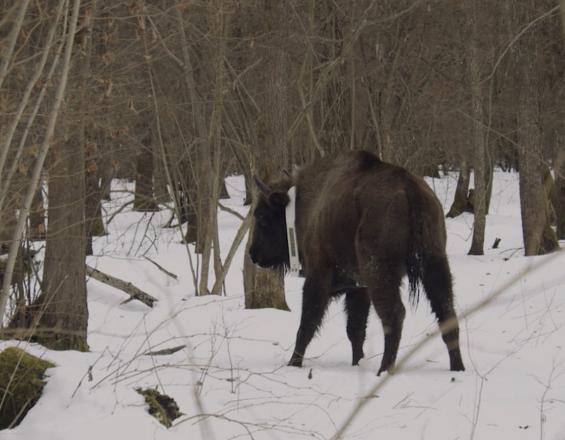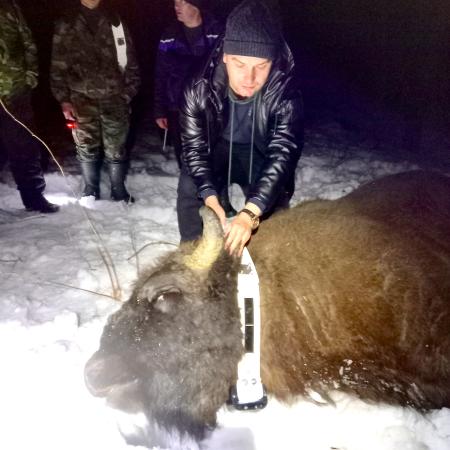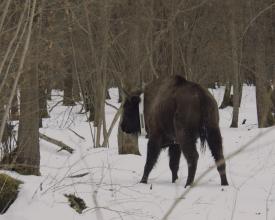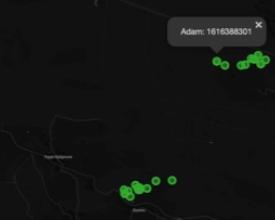
Perovskite solar panels supporting life lasting animal telemetry

Telemetry collars with flexible perovskite solar panels are created to support the life-lasting monitoring of animals. Collars consist of injecting printed perovskite solar panels covered by transparent epoxide and combined with a GPS fixing chip and LoRa data transmitter. Two innovative collars were put on two European (male and female) bisons at Styr hunting enterprise. The GPS coordinates were saved in the EEPROM memory in the collar and transmitted through the LoRaWAN communication protocol to the cloud and created a database. The database provides data to Grafana open-source service, enabling flexible visualizations of forms from multiple data sources. As a result of this, online monitoring of wildlife is established without the need to change the batteries in telemetry collars worn on animals.
Context
Challenges addressed
The telemetry study is quite costly and time-consuming especially when monitoring or tracking animals takes years. The replacement of batteries in telemetry devices or devices themselves is also time and money consuming and creates extra stress for animals that are tracked. Accumulator batteries also contain a hazardous element to the environment (e.g. heavy metals) and the volume of their usage should be reduced where possible.
Location
Process
Summary of the process
Two blocks combined in one device. Near 90 % of accumulator batteries as a source of energy are replaced by perovskite solar panels. There is no necessity to replace the telemetry collar or replace batteries because of discharging. Two ideas connected together. So independent sources of energy (ink printed perovskite solar panels) can be scaled and used on any monitoring device to feed sensors and transmit data.
Building Blocks
Integrated telemetry system in wildlife conservation and monitoring
A system that supports the monitoring on the global level and that could be available for all countries if data are provided. The GPS coordinates saved in the EEPROM memory need to be transmitted to the cloud server via gateways. The LoRaWAN communication protocol was used for transferring the data, which is Low Power, Wide Area Network designed to allow low-powered devices to communicate with internet-connected applications over a long-range wireless connection.
Enabling factors
Synchronized monitoring approach, especially for globally treated species.
It is crucial to see possibilities and opportunities of technologies and imaginations how they can be applied in nature conservation or modified to be applied.
Lesson learned
The integration process is very slow. You should clearly see the goal and build several mitigations strategies. A strong desire to achieve your vision help a lot.
Flexible perovskite solar pannels in wildlife conservation
Collaboration with development companies, IT, engineers may create an innovative approach in conservation. High efficient telemetry perovskite solar panels provide hundreds of thousands of times more energy than is needed for fixing GPS position and other data like temperature, humidity, etc., and transmitting it to the cloud. Because of the high efficiency of perovskite power cells of solar panels devices telemetry collar can work with low light density, dust, and severe condition efficiently enough to produce the right amount of energy. In this case, accumulator batteries size decreased up to 90%, and the is no reason to replace them every 3-5 years, which decrease the negative impact of accumulator batterie on the environment
Enabling factors
Multidiscipline cooperation is the key. When IT, engineers, conservationists, managers, foresters, veterinarians, and hunters working together for the common innovative goal. Success definitely in the cooperation of highly motivated people.
Lesson learned
The combination of the right people at the right place. It was really challenging during COVID-19 times because of borders closure between the engineering and implementation team. All windows of opportunities were use and also creativity.
Impacts
Implementation of life-lasting telemetry collars provide inside of spacial behaviour of animals during their whole life and help to understand the cascade of relationships in ecosystems (day/night, sex, season, habitat preferences). Understanding where is an animal at the exact time allows to improve species management and monitoring, which are the keys to human-wildlife conflict mitigation and poaching prevention. For example, two collared European bisons help to locate the flock easily and take measures by administration of managing enterprise for human-wildlife conflict prevention. Telemetry collars fed by flexible perovskite solar panels didn't need battery replacement and animals capturing repeatedly which also save resources and reduce the level of stress.
Beneficiaries
Conservationists, scientists, protected area managers, farmers, government, and other interested stakeholders.
Sustainable Development Goals
Story

If you are dreaming to be Elon Musk in nature conservation you need to be innovative. Animal telemetry collar combining innovative materials of super-efficient, flexible perovskite solar panels, telemetry chip, reduced battery size, no need for replacement and cheap LoRaWAN transmission technology push animal telemetry to a new level: animal life-lasting tracking. This is product is a combination of joint approaches on a multidisciplinary level - engineering, renewable energy, transmission, and proceeding technologies and multinational and multicultural cooperations. It contributes to the conservation of one of the biggest European terrestrial mammals - European bison with emphasis on live monitoring, management, human-wildlife conflict reduction, and poaching prevention.




